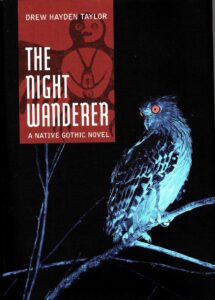Book review: The Night Wanderer: A Native Gothic Novel
 Reviewed by Karl Hele
Reviewed by Karl Hele
Aimed at a youth reader, Drew Hayden Taylor’s gothic novel, The Night Wanderer, is truly a marvellous read for anyone interested in a new Dracula’esque story. Yet, this novel is not simply a copy or homage to Bram Stoker. The Night Wanderer It is an Indigenization of the gothic novel with power and flair of its own – it is Taylor-Gothic.
In the vein of gothic novels, Taylor’s work holds an ominous foreboding presence always just out of reach for the characters and reader. By centring the story on a fictional reserve somewhere in southern Ontario, however, Taylor includes a sense of longing for the past, a desire to be in the present, and a need to engage in the future for all the characters. His depictions of the community and its people creates a vivid picture and a mind statement of “Hey, I think I know that place.”
The story follows both Pierre L’Errant (also known as Owl) and his return to Otter Lake, as well as Tiffany Hunter’s trials and tribulations as a teen growing up. Tiffany’s family, consisting of her Nokomis and father, rents a room to the mysterious L’Errant who explores the Otter Lake reserve at night. Both L’Errant and Tiffany are connected through a desire to experience more than the community can offer – simply, a desire to see and experience the world.
Through the story, we meet some of the community as well as learn that relations with the nearby settler community and cottagers are broken. The broken relations affect Tiffany and her family directly through her mom ‘running off’ with a white man. Tiffany is further affected through her relationship with a white boy. The conflicts between father and daughter, which the grandmother tries to mediate, eventually draw in their boarder L’Errant. The grandmother, and eventually Tiffany, twig to the notion that there is more to L’Errant than meets the eye. Eventually, L’Errant and Tiffany learn from and teach one another.
Overall, this is a fun read that contains lessons on loss, growing up, adventure, strength, the resilience of the human spirit, among other things. Like all good Anishinaabeg stories, these lessons are not preachy nor in-your-face; the lessons are yours to see or ignore as you read. I recommend that anyone interested in reading The Night Wanderer do so while sitting by a fire or beneath an old magnificent tree next to a shoreline so you can take in not only the text but the visuals, smells, and sounds of the living land.
Drew Hayden Taylor, The Night Wanderer: A Native Gothic Novel. Toronto: Annick Press, 2007.
ISBN: 978-1554510993


